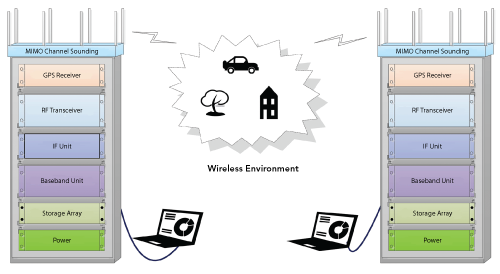In recent years, research institutions, operators, equipment, IC and instrument manufacturers around the world have carried out key 5G technology validation and prototype testing in succession.8 According to China’s 5G R&D test plan, the next step will be testing technical solutions introduced by manufacturers and, finally, system testing for typical 5G services based on small-scale networks.
Compared to traditional testing in the 3G/4G era, three technical characteristics of 5G impose enormous challenges on test instruments and methods:
- the introduction of microwave and mmWave bands above 6 GHz
- the generation, reception and storage of ultra-wideband signals with bandwidths of hundreds of MHz or even GHz; and
- the design and application of large-scale antenna arrays, with 64, 128 or more channels.
5G TEST TECHNOLOGIES
The following sections explain the influences these characteristics have on 5G test instruments and test technology with respect to different test scenarios for 5G wireless communications. Existing solutions are introduced as well.
5G Channel Sounding and Modeling
The wireless channel is one of the core components of the wireless communications system. Physical properties of the wireless channel are characterized by a series of parameters, such as channel impulse response, path loss, Doppler delay, power delay profile and angle of arrival. Channel sounding can help extract these MIMO channel parameters and provide an important reference for subsequent 5G channel modeling and standardization. The basic structure of the channel sounding system is shown in Figure 1, which includes the signal transmission/receiving instruments and measurement/analysis software.

Figure 1 5G channel sounding system.
With the development of 5G technology, the traditional 3G/4G channel sounding system can neither cope with new test challenges nor be upgraded to achieve better performance. Characteristics of mmWave channels are not yet fully explored or understood, and the upgrade of traditional dedicated channel sounding equipment is likely to be costly, due to inadequacies dealing with flexible testing from 6 to 100 GHz. The ability to generate, receive and store ultra-high speed baseband signals will need to be greatly improved, as well. The introduction of large-scale antenna arrays significantly increases the required computational capacity of channel sounding instruments, making new multi-channel RF transceiver components the inevitable choice. Hardware and software platforms must support massive data analysis and channel parameter extraction.
In recent years, enterprises and academic institutions around the world have proposed a variety of solutions for 5G channel sounding based on a combination of existing products. Keysight Technologies proposed a mmWave MIMO channel sounding system.9 Rohde & Schwarz (R&S) proposed a scheme that supports fast measurement of both indoor and outdoor time domain channels with operating frequencies up to 100 GHz and bandwidths as wide as 2 GHz.10 Various research projects are investigating 5G mmWave channel measurements and modeling, including METIS, NYU WIRELESS,11 mmMAGIC, MiWEBA and 3GPP.
